YAMAHA XL 700 2001 Owners Manual
Manufacturer: YAMAHA, Model Year: 2001, Model line: XL 700, Model: YAMAHA XL 700 2001Pages: 111, PDF Size: 12.05 MB
Page 91 of 111
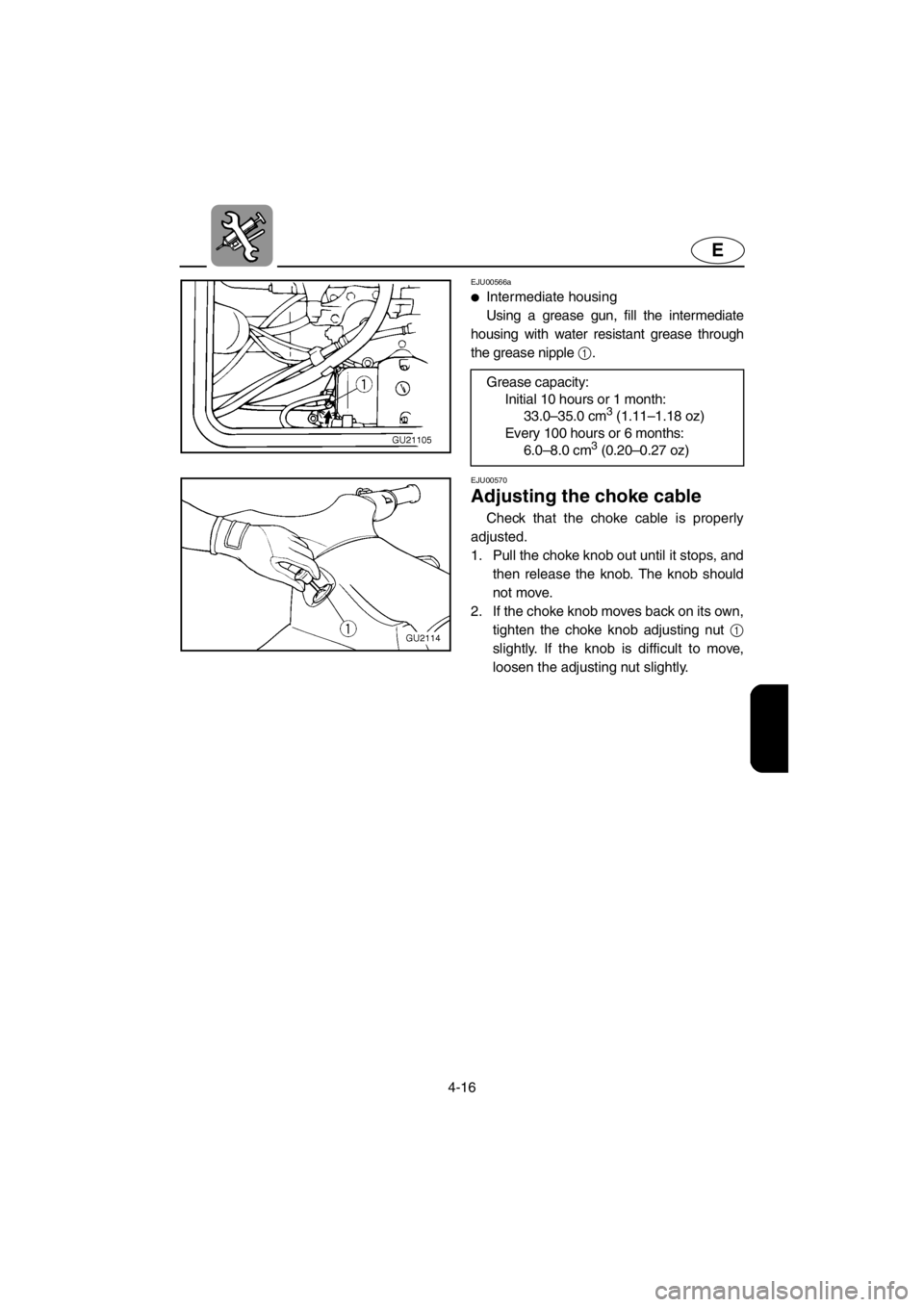
4-16
E
EJU00566a
●Intermediate housing
Using a grease gun, fill the intermediate
housing with water resistant grease through
the grease nipple 1.
Grease capacity:
Initial 10 hours or 1 month:
33.0–35.0 cm
3 (1.11–1.18 oz)
Every 100 hours or 6 months:
6.0–8.0 cm
3 (0.20–0.27 oz)
EJU00570
Adjusting the choke cable
Check that the choke cable is properly
adjusted.
1. Pull the choke knob out until it stops, and
then release the knob. The knob should
not move.
2. If the choke knob moves back on its own,
tighten the choke knob adjusting nut 1
slightly. If the knob is difficult to move,
loosen the adjusting nut slightly.
E_F0M-72-4.fm Page 16 Thursday, July 27, 2000 9:53 AM
Page 92 of 111
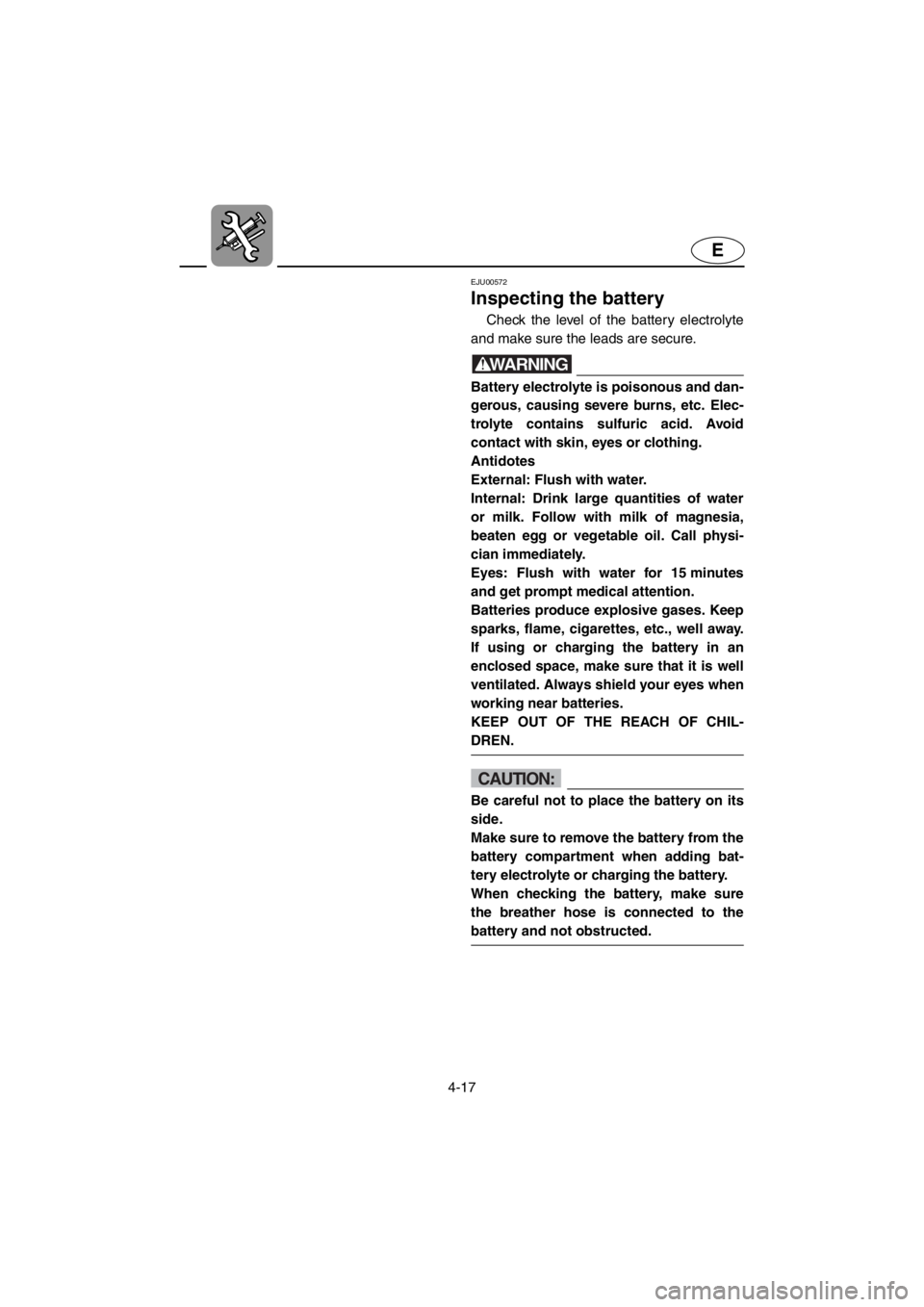
4-17
E
EJU00572
Inspecting the battery
Check the level of the battery electrolyte
and make sure the leads are secure.
WARNING
Battery electrolyte is poisonous and dan-
gerous, causing severe burns, etc. Elec-
trolyte contains sulfuric acid. Avoid
contact with skin, eyes or clothing.
Antidotes
External: Flush with water.
Internal: Drink large quantities of water
or milk. Follow with milk of magnesia,
beaten egg or vegetable oil. Call physi-
cian immediately.
Eyes: Flush with water for 15 minutes
and get prompt medical attention.
Batteries produce explosive gases. Keep
sparks, flame, cigarettes, etc., well away.
If using or charging the battery in an
enclosed space, make sure that it is well
ventilated. Always shield your eyes when
working near batteries.
KEEP OUT OF THE REACH OF CHIL-
DREN.
CAUTION:
Be careful not to place the battery on its
side.
Make sure to remove the battery from the
battery compartment when adding bat-
tery electrolyte or charging the battery.
When checking the battery, make sure
the breather hose is connected to the
battery and not obstructed.
E_F0M-72-4.fm Page 17 Thursday, July 27, 2000 9:53 AM
Page 93 of 111
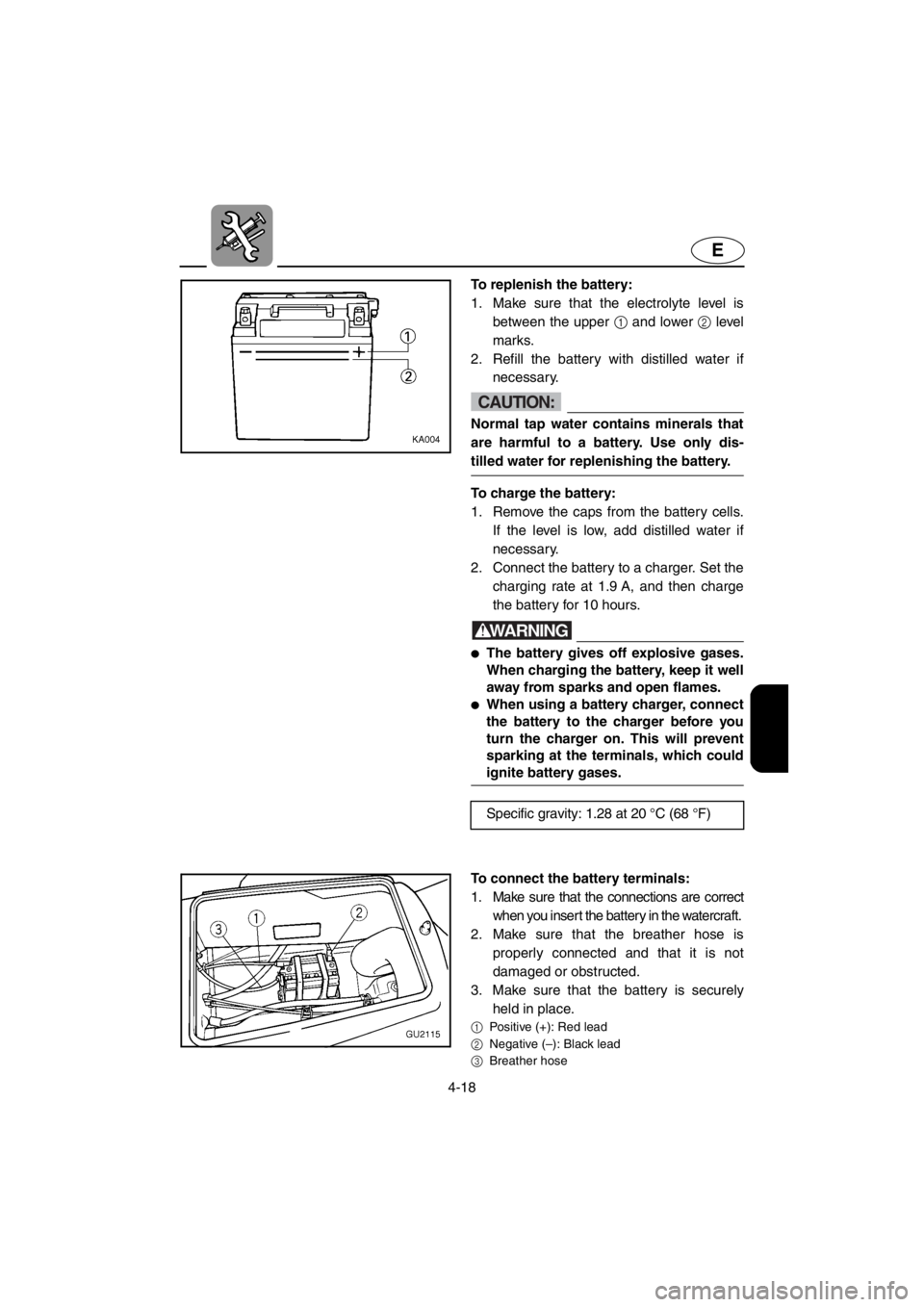
4-18
E
To replenish the battery:
1. Make sure that the electrolyte level is
between the upper 1 and lower 2 level
marks.
2. Refill the battery with distilled water if
necessary.
CAUTION:
Normal tap water contains minerals that
are harmful to a battery. Use only dis-
tilled water for replenishing the battery.
To charge the battery:
1. Remove the caps from the battery cells.
If the level is low, add distilled water if
necessary.
2. Connect the battery to a charger. Set the
charging rate at 1.9 A, and then charge
the battery for 10 hours.
WARNING
●The battery gives off explosive gases.
When charging the battery, keep it well
away from sparks and open flames.
●When using a battery charger, connect
the battery to the charger before you
turn the charger on. This will prevent
sparking at the terminals, which could
ignite battery gases.
Specific gravity: 1.28 at 20 °C (68 °F)
To connect the battery terminals:
1. Make sure that the connections are correct
when you insert the battery in the watercraft.
2. Make sure that the breather hose is
properly connected and that it is not
damaged or obstructed.
3. Make sure that the battery is securely
held in place.
1Positive (+): Red lead
2Negative (–): Black lead
3Breather hose
E_F0M-72-4.fm Page 18 Thursday, July 27, 2000 9:53 AM
Page 94 of 111
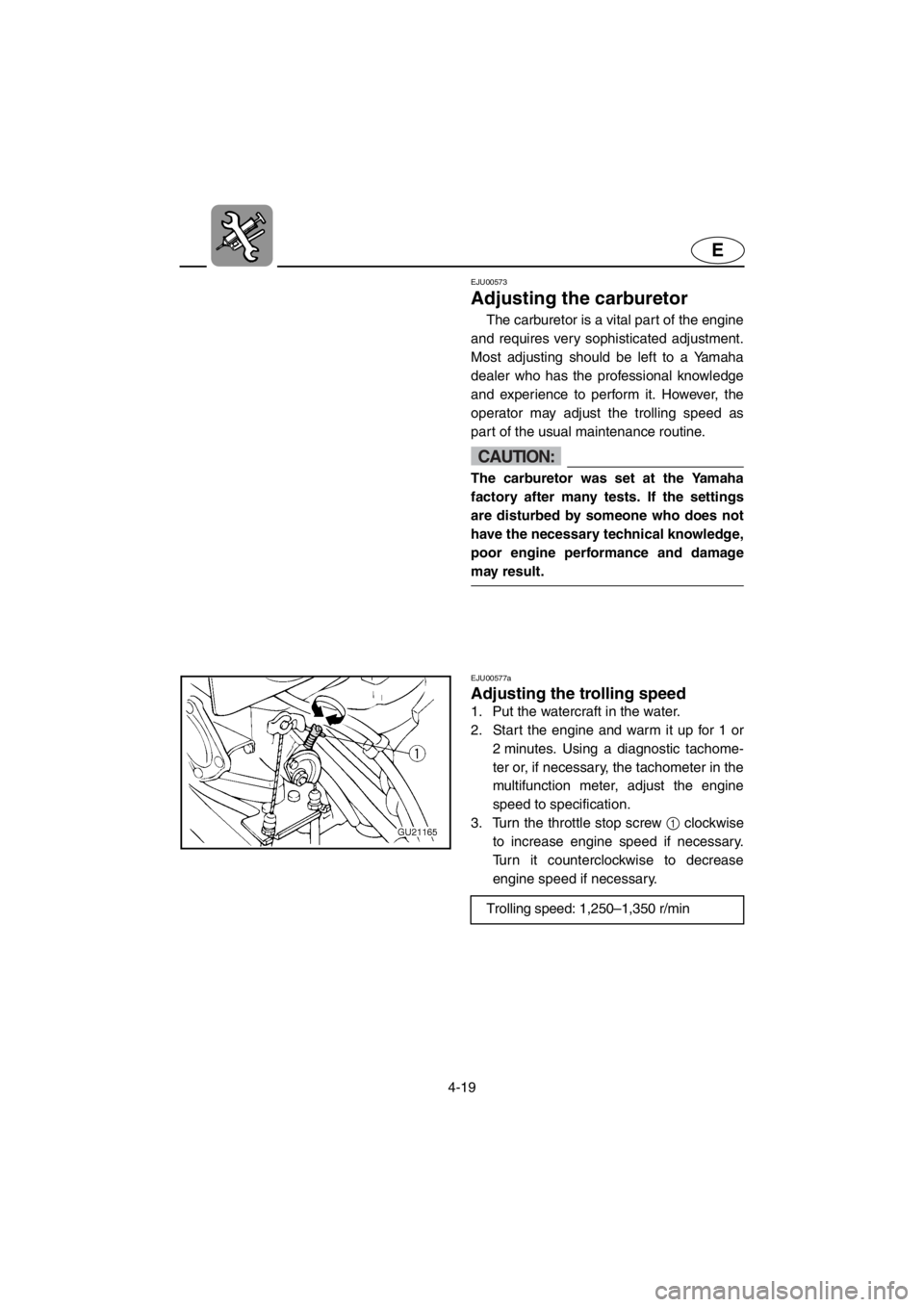
4-19
E
EJU00573
Adjusting the carburetor
The carburetor is a vital part of the engine
and requires very sophisticated adjustment.
Most adjusting should be left to a Yamaha
dealer who has the professional knowledge
and experience to perform it. However, the
operator may adjust the trolling speed as
part of the usual maintenance routine.
CAUTION:
The carburetor was set at the Yamaha
factory after many tests. If the settings
are disturbed by someone who does not
have the necessary technical knowledge,
poor engine performance and damage
may result.
EJU00577a
Adjusting the trolling speed
1. Put the watercraft in the water.
2. Start the engine and warm it up for 1 or
2 minutes. Using a diagnostic tachome-
ter or, if necessary, the tachometer in the
multifunction meter, adjust the engine
speed to specification.
3. Turn the throttle stop screw 1 clockwise
to increase engine speed if necessary.
Turn it counterclockwise to decrease
engine speed if necessary.
Trolling speed: 1,250–1,350 r/min
E_F0M-72-4.fm Page 19 Thursday, July 27, 2000 9:53 AM
Page 95 of 111
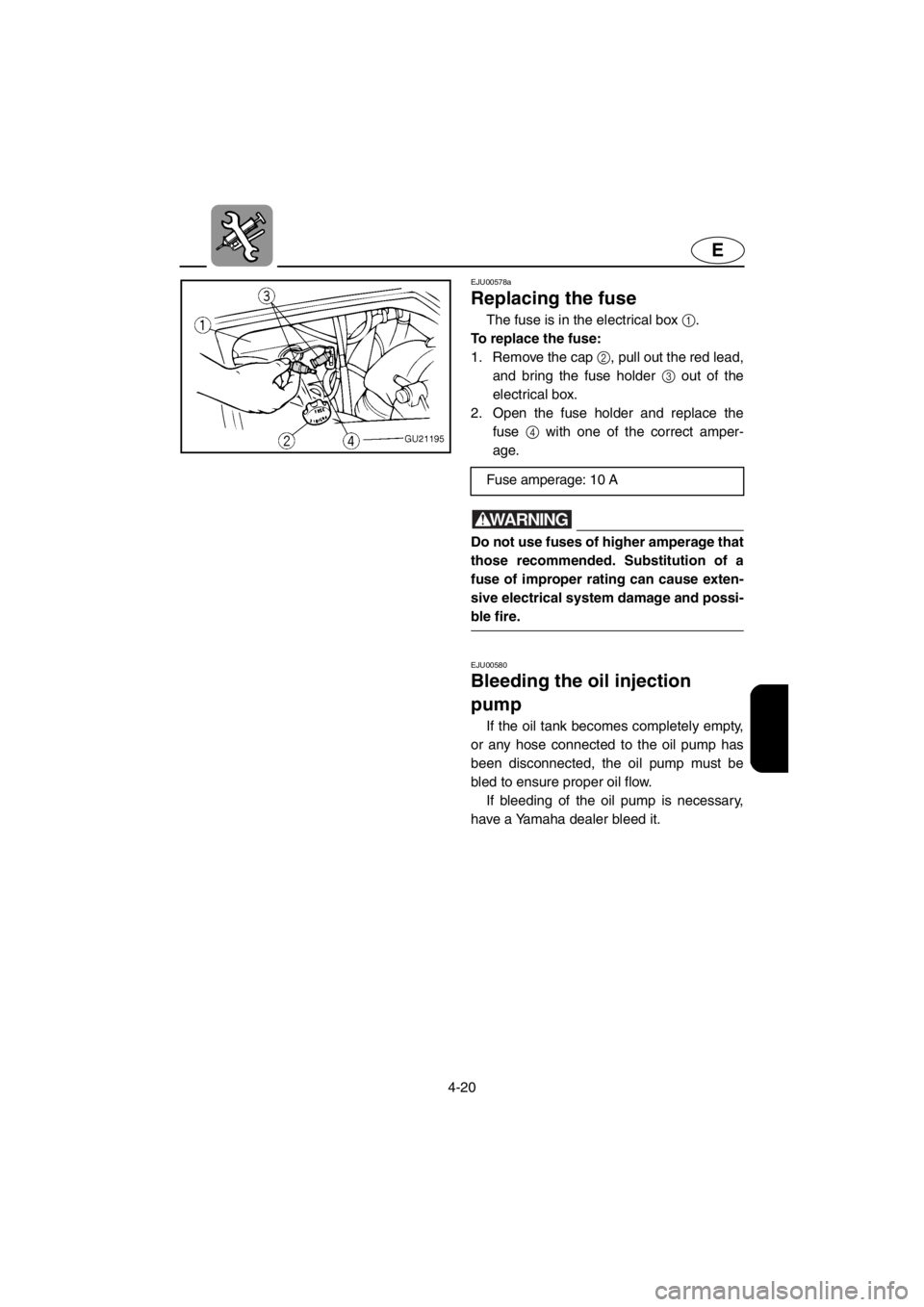
4-20
E
EJU00578a
Replacing the fuse
The fuse is in the electrical box 1.
To replace the fuse:
1. Remove the cap 2, pull out the red lead,
and bring the fuse holder 3 out of the
electrical box.
2. Open the fuse holder and replace the
fuse4 with one of the correct amper-
age.
WARNING
Do not use fuses of higher amperage that
those recommended. Substitution of a
fuse of improper rating can cause exten-
sive electrical system damage and possi-
ble fire.
EJU00580
Bleeding the oil injection
pump
If the oil tank becomes completely empty,
or any hose connected to the oil pump has
been disconnected, the oil pump must be
bled to ensure proper oil flow.
If bleeding of the oil pump is necessary,
have a Yamaha dealer bleed it.Fuse amperage: 10 A
E_F0M-72-4.fm Page 20 Thursday, July 27, 2000 9:53 AM
Page 96 of 111
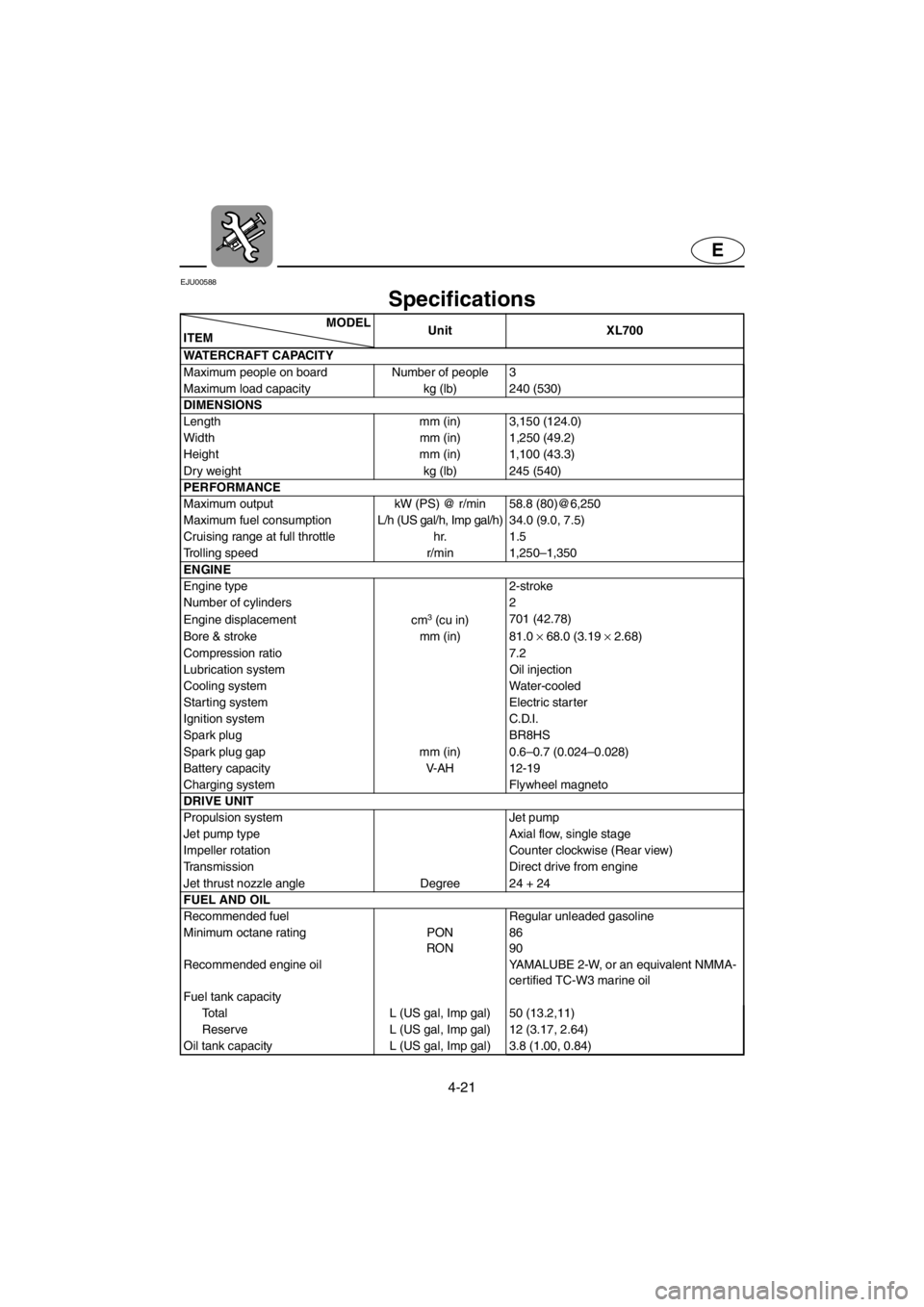
4-21
E
EJU00588
Specifications
MODEL
ITEMUnit XL700
WATERCRAFT CAPACITY
Maximum people on board Number of people 3
Maximum load capacity kg (lb) 240 (530)
DIMENSIONS
Length mm (in) 3,150 (124.0)
Width mm (in) 1,250 (49.2)
Height mm (in) 1,100 (43.3)
Dry weight kg (lb) 245 (540)
PERFORMANCE
Maximum output kW (PS) @ r/min 58.8 (80)@6,250
Maximum fuel consumption L/h (US gal/h, Imp gal/h) 34.0 (9.0, 7.5)
Cruising range at full throttle hr. 1.5
Trolling speed r/min 1,250–1,350
ENGINE
Engine type 2-stroke
Number of cylinders 2
Engine displacement
cm
3 (cu in)701 (42.78)
Bore & stroke mm (in) 81.0 ×
68.0 (3.19 ×
2.68)
Compression ratio 7.2
Lubrication system Oil injection
Cooling system Water-cooled
Starting system Electric starter
Ignition system C.D.I.
Spark plug BR8HS
Spark plug gap mm (in) 0.6–0.7 (0.024–0.028)
Battery capacity V-AH 12-19
Charging system Flywheel magneto
DRIVE UNIT
Propulsion system Jet pump
Jet pump type Axial flow, single stage
Impeller rotation Counter clockwise (Rear view)
Transmission Direct drive from engine
Jet thrust nozzle angle Degree 24 + 24
FUEL AND OIL
Recommended fuel Regular unleaded gasoline
Minimum octane rating PON
RON86
90
Recommended engine oil YAMALUBE 2-W, or an equivalent NMMA-
certified TC-W3 marine oil
Fuel tank capacity
Total L (US gal, Imp gal) 50 (13.2,11)
Reserve L (US gal, Imp gal) 12 (3.17, 2.64)
Oil tank capacity L (US gal, Imp gal) 3.8 (1.00, 0.84)
E_F0M-72-4.fm Page 21 Thursday, July 27, 2000 9:53 AM
Page 97 of 111
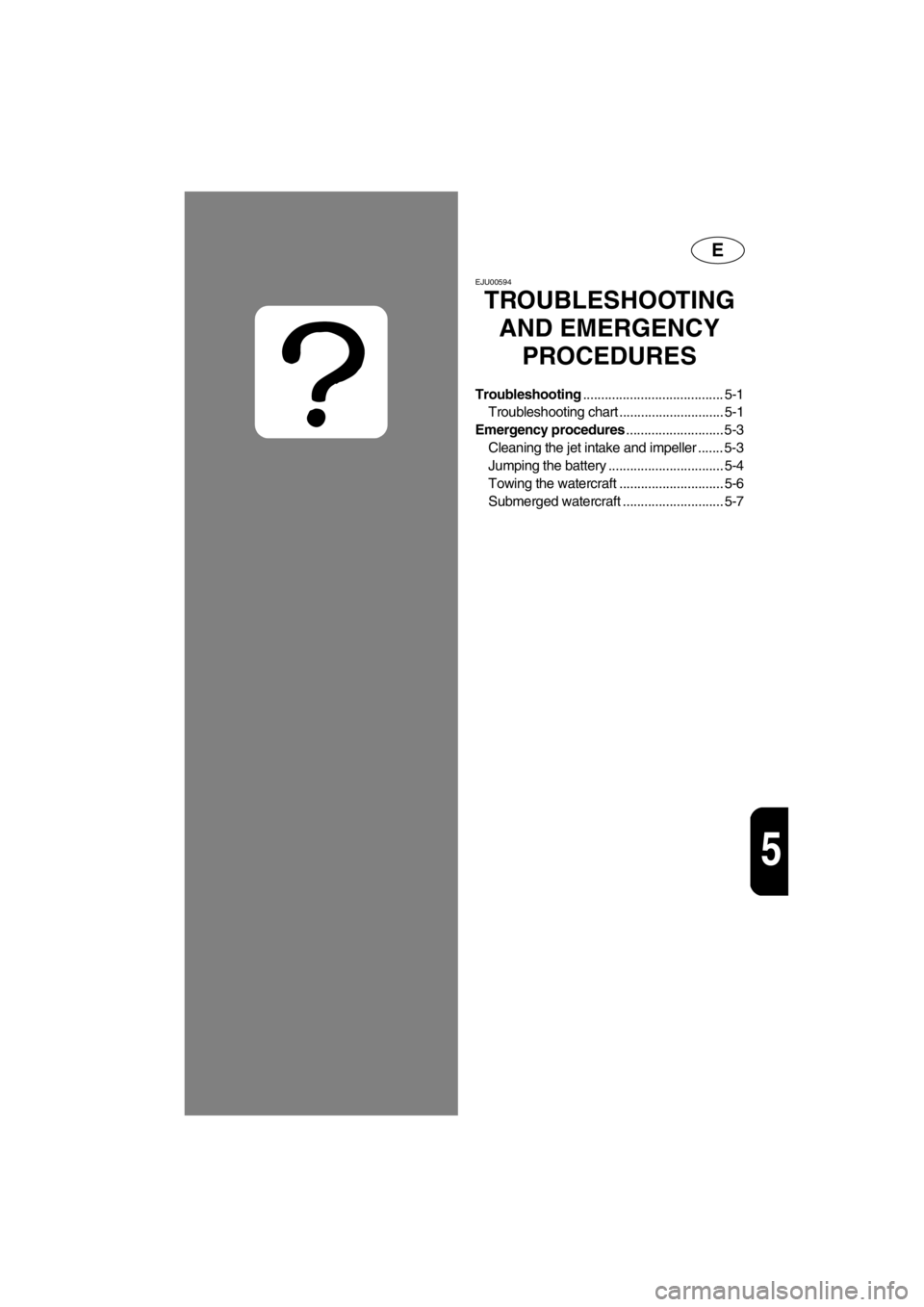
E
5
EJU00594
TROUBLESHOOTING
AND EMERGENCY
PROCEDURES
Troubleshooting....................................... 5-1
Troubleshooting chart ............................. 5-1
Emergency procedures........................... 5-3
Cleaning the jet intake and impeller ....... 5-3
Jumping the battery ................................ 5-4
Towing the watercraft ............................. 5-6
Submerged watercraft ............................ 5-7
E_F0M-72-5TOC.fm Page 1 Thursday, July 27, 2000 9:57 AM
Page 98 of 111
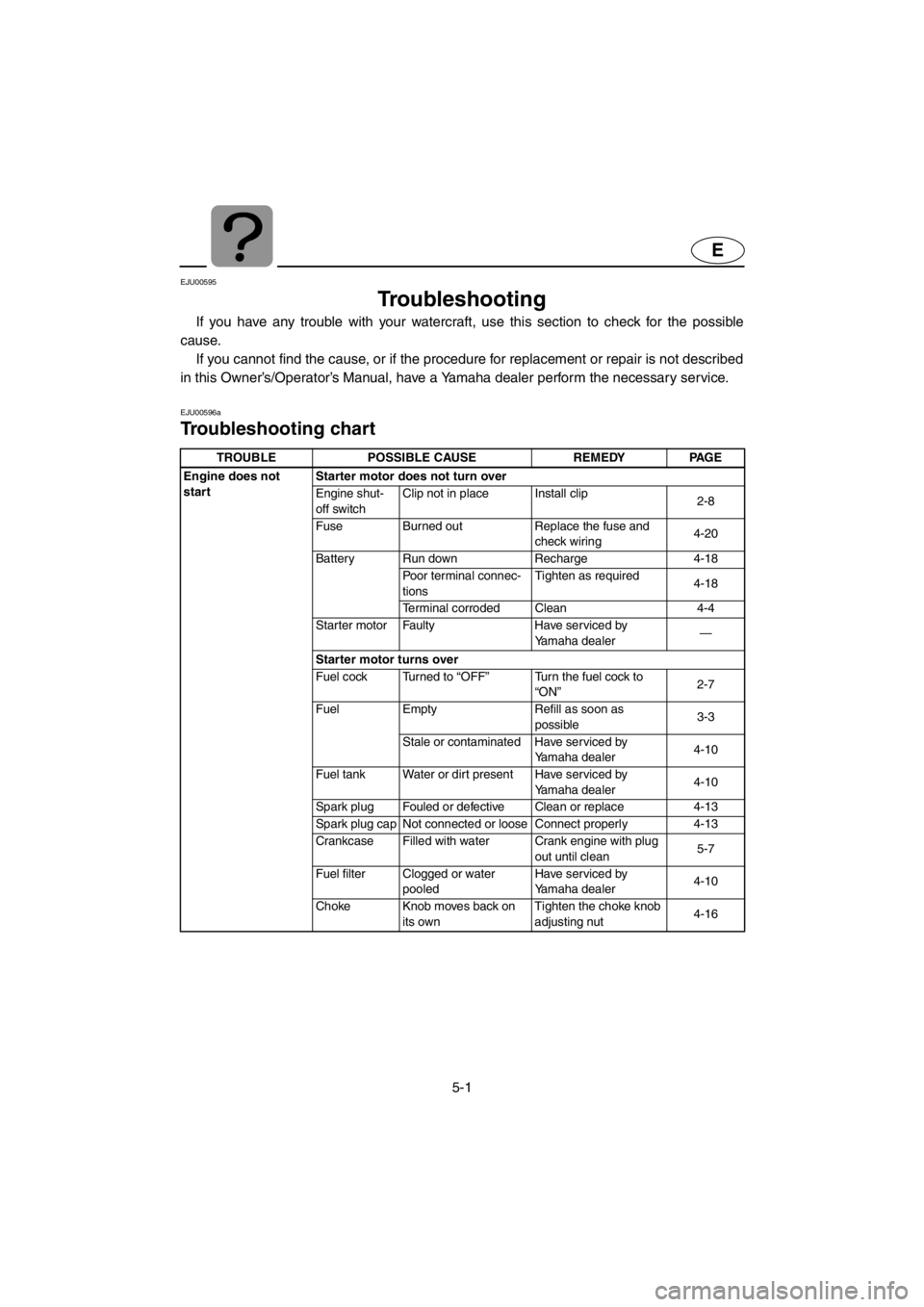
5-1
E
EJU00595
Troubleshooting
If you have any trouble with your watercraft, use this section to check for the possible
cause.
If you cannot find the cause, or if the procedure for replacement or repair is not described
in this Owner’s/Operator’s Manual, have a Yamaha dealer perform the necessary service.
EJU00596a
Troubleshooting chart
TROUBLE POSSIBLE CAUSE REMEDY PAGE
Engine does not
startStarter motor does not turn over
Engine shut-
off switchClip not in place Install clip
2-8
Fuse Burned out Replace the fuse and
check wiring4-20
Battery Run down Recharge 4-18
Poor terminal connec-
tionsTighten as required
4-18
Terminal corroded Clean 4-4
Starter motor Faulty Have serviced by
Yamaha dealer—
Starter motor turns over
Fuel cock Turned to “OFF” Turn the fuel cock to
“ON”2-7
Fuel Empty Refill as soon as
possible3-3
Stale or contaminated Have serviced by
Yamaha dealer4-10
Fuel tank Water or dirt present Have serviced by
Yamaha dealer4-10
Spark plug Fouled or defective Clean or replace 4-13
Spark plug cap Not connected or loose Connect properly 4-13
Crankcase Filled with water Crank engine with plug
out until clean5-7
Fuel filter Clogged or water
pooledHave serviced by
Yamaha dealer4-10
Choke Knob moves back on
its ownTighten the choke knob
adjusting nut4-16
E_F0M-72-5.fm Page 1 Thursday, July 27, 2000 9:58 AM
Page 99 of 111
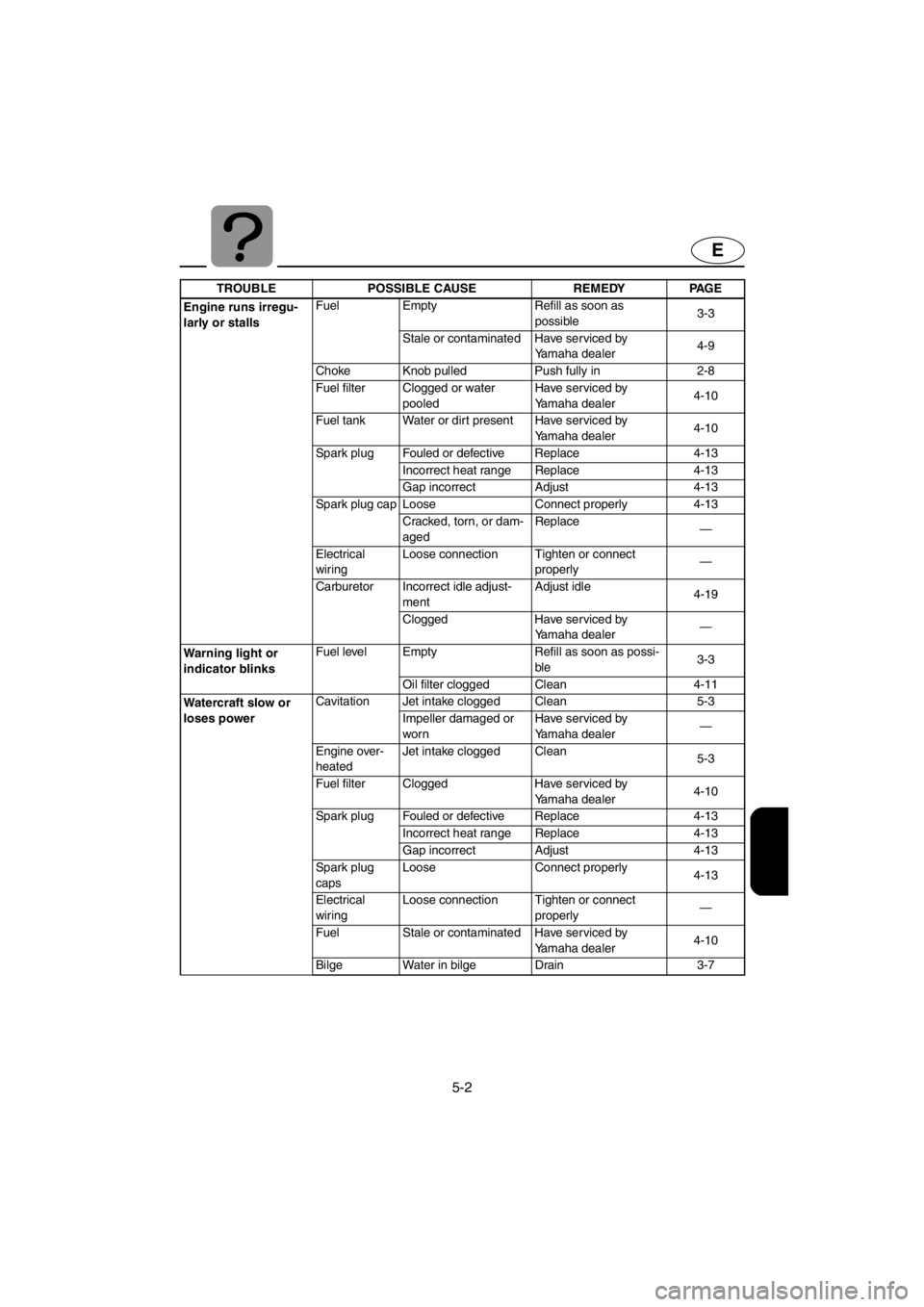
5-2
E
Engine runs irregu-
larly or stallsFuel Empty Refill as soon as
possible3-3
Stale or contaminated Have serviced by
Yamaha dealer4-9
Choke Knob pulled Push fully in 2-8
Fuel filter Clogged or water
pooledHave serviced by
Yamaha dealer4-10
Fuel tank Water or dirt present Have serviced by
Yamaha dealer4-10
Spark plug Fouled or defective Replace 4-13
Incorrect heat range Replace 4-13
Gap incorrect Adjust 4-13
Spark plug cap Loose Connect properly 4-13
Cracked, torn, or dam-
agedReplace
—
Electrical
wiringLoose connection Tighten or connect
properly—
Carburetor Incorrect idle adjust-
mentAdjust idle
4-19
Clogged Have serviced by
Yamaha dealer—
Warning light or
indicator blinksFuel level Empty Refill as soon as possi-
ble3-3
Oil filter clogged Clean 4-11
Wate rcr af t slow or
loses powerCavitation Jet intake clogged Clean 5-3
Impeller damaged or
wornHave serviced by
Yamaha dealer—
Engine over-
heatedJet intake clogged Clean
5-3
Fuel filter Clogged Have serviced by
Yamaha dealer4-10
Spark plug Fouled or defective Replace 4-13
Incorrect heat range Replace 4-13
Gap incorrect Adjust 4-13
Spark plug
capsLoose Connect properly
4-13
Electrical
wiringLoose connection Tighten or connect
properly—
Fuel Stale or contaminated Have serviced by
Yamaha dealer4-10
Bilge Water in bilge Drain 3-7 TROUBLE POSSIBLE CAUSE REMEDY PAGE
E_F0M-72-5.fm Page 2 Thursday, July 27, 2000 9:58 AM
Page 100 of 111

5-3
E
EJU00597
Emergency procedures
EJU00598
Cleaning the jet intake and
impeller
If weeds or debris get caught in the intake
or impeller, cavitation can occur, causing jet
thrust to decrease even though engine
speed rises. If this condition is allowed to
continue, the engine will overheat and may
seize. If there is any sign that the jet intake
or impeller is clogged with weeds or debris,
beach the watercraft and check the intake
and impeller. Always stop the engine before
beaching the watercraft.
WARNING
Before attempting to remove weeds or
debris from the jet intake or impeller
areas, shut the engine off and remove
the clip from the engine shut-off switch.
Severe injury or death could result from
contact with the rotating parts of the jet
pump.
1. Turn the watercraft on its side as shown.
CAUTION:
●Place a suitable clean cloth or carpet-
ing underneath the watercraft to pro-
tect it from abrasions and scratches.
●Always turn the watercraft over onto
its port (left) side.
●When turning the watercraft on its
side, support the bow so the handle-
bars cannot be bent or damaged.
E_F0M-72-5.fm Page 3 Thursday, July 27, 2000 9:58 AM